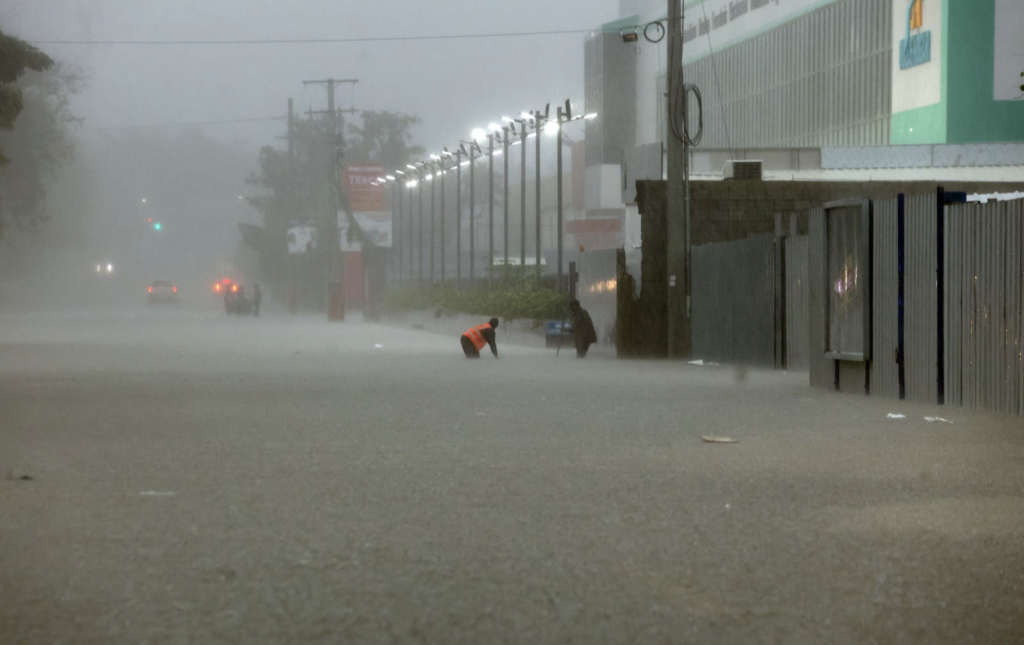Copyright dr1

The storm that came to stay has caused flooding and lots of economic losses from lock down. Tropical Storm Melissa was born well to the south of the island of Hispaniola (Haiti and the DR) but has overstayed its welcome in the Caribbean. The storm has kept the slowest pace of storms in the decades, moving 2km to 6km per hour at times and just lingering in the Caribbean. Since the effects began to be felt in the Dominican Republic on Monday, 20 October 2025 in the afternoon, it seemingly tiptoed as it made its way north, a bit to the east, and then to the west, always spreading out its bands and impact. Indeed, what began last week as an interesting low pressure area out in the middle of the Atlantic Ocean has become Hurricane Melissa, a major hurricane now over Jamaica by the time this article is read. It missed a direct hit to the Dominican Republic by several hundred miles, but its rains and heavy surf caused at least two fatalities, caused over a million persons lost access to drinking water. Dozens and dozens of communities were cut off by flooding waters. The storm has been the headline news for the past five days and might well be the most important news for this week, too. Former general Juan Manuel Mendez, the head of the Dominican Republic’s emergency response efforts, the COE, told reporters that he had never seen a tropical storm behave in such a strange manner. The storm stalled to the southwest of the island of Hispaniola and dumped water day after day on Haiti and much of the Dominican Republic. Areas around Santo Domingo reported as much as seven inches (177.9 mm) of water, and there were reports from the area of Barahona that rivers were already overflowing. Of course, urban flooding was reported in the cities of Santo Domingo, San Cristobal, and East Santo Domingo, and landslides and rockslides were reported in the areas of Constanza and San Jose de Ocoa. 28 provinces of 32 were under some kind of alert as of Saturday, with San Juan de la Maguana, Pedernales, Barahona, Azua, Peravia, San Jose de Ocoa, San Cristobal, Monte Plata, Santo Domingo, the National District, San Pedro de Macoris and La Romana under a red alert, the highest level. Agencies tasked with handling water, mainly Inapa and Indrhi, were reporting nearly 50 local aqueducts out of service, local flooding conditions in areas of the deep south, such as Tamayo in the southwest, and at least three of the nation’s dams were spilling water into rivers. In fact, due to the discharge from the Valdesia system, a warning was issued to the down-river population not to attempt crossing the Nizao River because of the increased water flow. Along the southern shoreline there were constant warnings due to very large waves, and over 30 persons were evacuated from Saona Island. A young boy who went out to play in the rain is suspected of have been carried away by a very large wave along España Avenue. In North Santo Domingo, a 71-year old man was swept away by the current as he tried to clean out a drainage grating to ease local flooding. In Santo Domingo, the head of the Unified Council of Electricity Distributing Companies (CUED), Celso Marranzini, reported that 99% of the nation’s electricity system is stable and serving the public. He noted that proper preparation, that included equipment, spare parts and emergency teams ready to go out, allowed the system to correct the local blackout situations that occurred during the heaviest of rains. The floating bridge across the Ozama River had to be shut down for heavy equipment to move in and remove the huge amount of garbage and water lilies that came down the Ozama and Isabela rivers and lodged against the pontoon bridge. On the bright side, the Cibao Valley enjoyed light rain, without any heavy breezes, and this benefitted the entire valley. The Tavera-Bao reservoir reached the optimum level for the Santiago Water Corporation (Coraasan), guaranteeing water for Santiago and nearby areas. Reports from the Moncion reservoir state that the dam is at 97% of capacity, and the counter dam on the Mao river was releasing water downstream. The Rincon dam between La Vega and Bonao was at 89% capacity. There were no reports of damage to crops or livestock in the Cibao. In fact, recent dry conditions had stalled much of the planting season, and with these rains the farmers were out planting their fields. In the South, the Ocoa river overflowed its banks and caused some damage to agriculture in the San Jose de Ocoa area, and in Paravia (Bani), the Nizao river caused some damage. In the opinion of the Ministry of Agriculture, in general, the rains have been beneficial. The media has reported on the economic losses for business of the four-day shutdown. UASD chief economist Antonio Ciriaco quantified the losses at RD$10 billion, as reported in Hoy. Likewise, while many farming areas benefitted from the rains, in Barahona there are reports that the coffee sector was impacted because there was not enough time nor the manpower to harvest the ripe coffee beans. Read more:Hoy Listin Diario Diario Libre Hoy Newsweek The Guardian 27 October 2025



